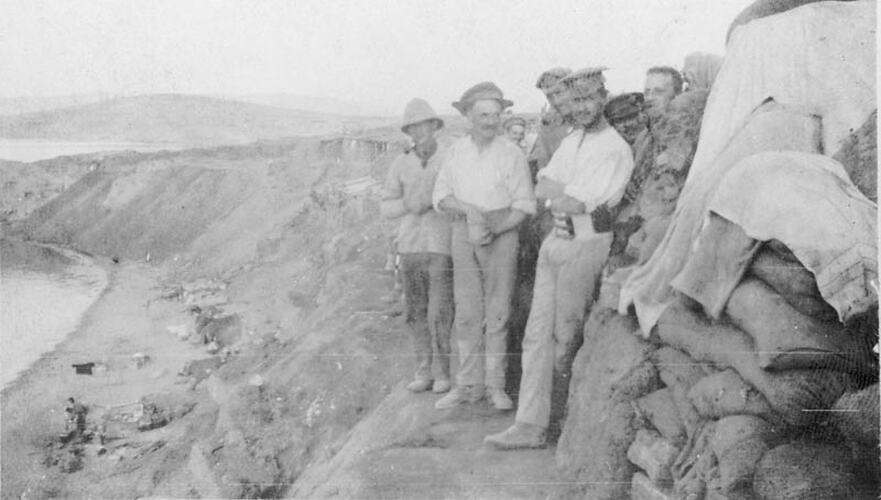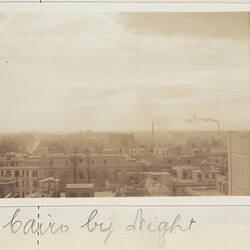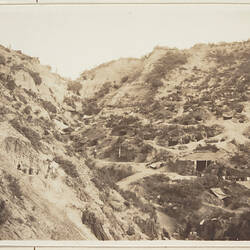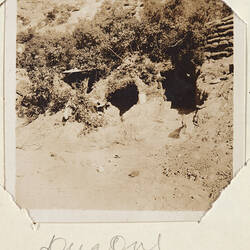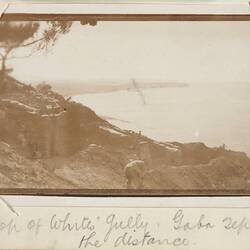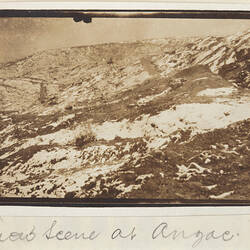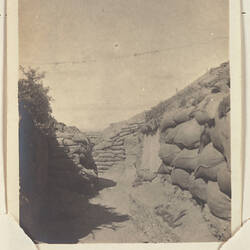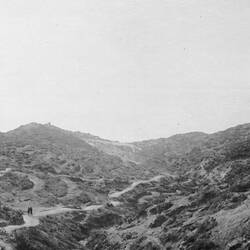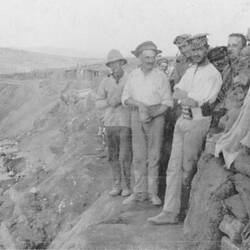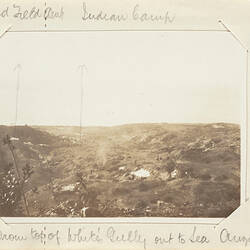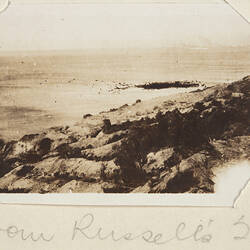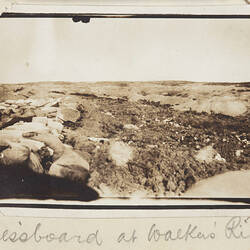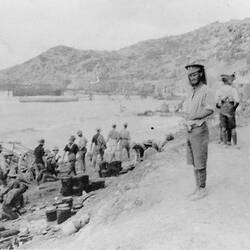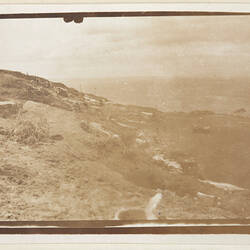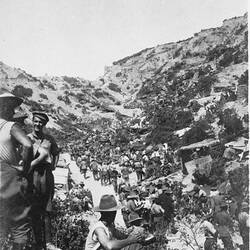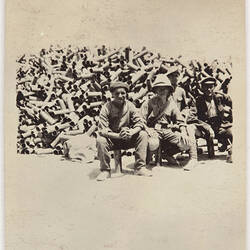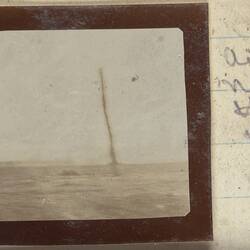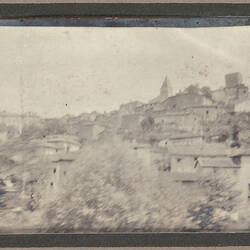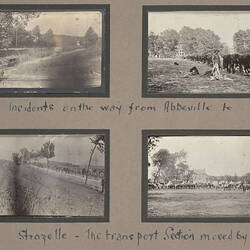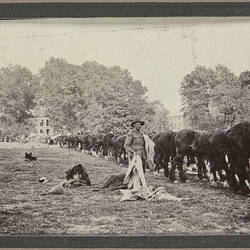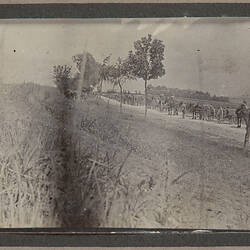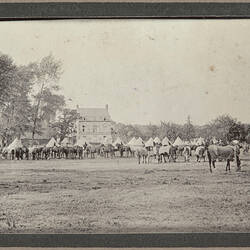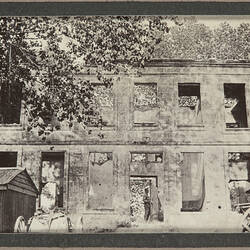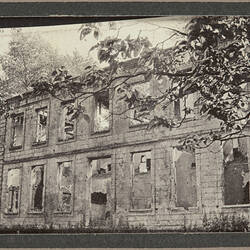John Lord, who served in the AIF in World War I, service # 6252, was the source of a sizeable collection of significant World War I material held by Museum Victoria, including six photograph albums containing hundreds of original images, 14 postcard albums, pamphlets, magazines, an almanac and a diary. It is believed that some of the material did not originally belong to Lord.
He was born in Prospect, South Australia, in 1896 to W.B. and Matilda Lord. His service record describes him as 5ft 5 ½ inches tall, 138 pounds, of fair complexion with blue eyes and fair hair, and Anglican by religion. Aged 19 years 5 months, he had already completed four years as a voluntary cadet while at school, and was an unmarried bank clerk in civilian life.
Lord enlisted in the Australian Army at H Group Base Infantry in Keswick, South Australia on 8 June 1915. On 27 October 1915 he left Australia on HMAT A724 'Benalla' bound for Egypt, where the Australian troops trained before going into battle. He was a member of the 1st Australian Stationary Hospital - 11th Reinforcements. The 1st Australian Stationary Hospital was a South Australian unit. He was to be paid 5 shillings a day (gross) - 1 shilling was deducted per day that he could only access after completing his service.
Lord stopped for a relatively short time in Egypt before being shipped out to the war zone. (He returned to Egypt for a longer period (four months) afterwards, before leaving for France.) On 4 November 1915 he joined the Mediterranean Expeditionary Force (MEF) on the hospital ship 'Assaye' from Alexandria to Gallipoli (MEF was part of the British Army during World War I; the MEF's war diaries are held in the Australian War Memorial - AWM6). There is no record of Lord landing on, or serving in, Gallipoli. In fact in a postcard likely written by him, ST 040547, Lord notes that 'we are not wanted there' (referring to Anzac Cove); instead is he located at Lemnos Island. His collection does, however, contain many photographs taken at Gallipoli, perhaps taken by other photographers.
Lord travelled back to Egypt in December 1915. On 2 February 1916 he transferred from the H Group Base Infantry to the 3rd Field Ambulance, at Tel-el-Kebir (110 km north-north-east of Cairo, and the site of a battle between the colonial English army and rebelling Egyptian forces in 1882). On 6 June 1916 he was sent to France ('taken on strength'). Between 2 July 1916 to 20 October 1918 he served on the Western Front. During this time he was promoted several times through the ranks of Corporal, to Sergeant, and Staff Sergeant at 4th Division Headquarters, and received the award of the Meritorious Service Medal on 18 January 1919. He returned to Australia on 30 October 1919, and was discharged from service on 12 March 1920.
John Lord enjoyed relatively good health during his wartime service. During his time in the Middle East he was admitted to hospital just once, for PUO - 'Pyrexia of uncertain origin' - in other words, a fever. No other period of ill-health are recorded in his National Archives records.
Lord passed away in Australia on 8 August 1951, at the age of 55.
Several of Lord's relatives also served in the war:
Brother: Pte Harry Lord, 48th Battalion, returned to Australia 1/7/1919
Uncle: Pte Walter Henry Gray, 4th Pioneer Battalion, returned to Australia 1917
Cousin: Pte Edwin Charles Gray, 32nd Battalion, killed in action, 20/7/1916
Cousin: Cpl Alfred James Gray, 10th Battalion, returned to Australia 21/7/1918
(Source: Australian Imperial Force website < http://www.aif.adfa.edu.au/index.html>, accessed 23/9/2010.)
References
Information gleaned from service record, John Lord, National Archives of Australia item barcode 8204908 and relevant secondary sources.
Manning Clark, A History of Australia, Melbourne University Press, 1992, 455 infra. See also Australian Government website, http://www.cultureandrecreation.gov.au/articles/anzac/, retrieved 22 September 2010.
Private John Jensen, service no. 955 (1st Battalion, H Company), letter written 28 August 1915 (while he was in England recuperating from wounds received at Gallipoli), http://alh-research.tripod.com/Light_Horse/index.blog/1973775/first-wassa-egypt-april-2-1915-john-jack-jensens-account/, retrieved 23 September 2010.
Lt. David Doull, With the Anzacs in Egypt: Life and Scenes in the Land of the Pharaohs, as Seen Through Australian Spectacles, Sydney: JA Packer, 1916, 64, 43. Doull was 31 when he joined AIF in 1915. A member of the 17th Battalion, 5th Brigade, he was severely wounded by a shell at Gallipoli on 23 September 1915. He couldn't walk for some time, as his leg was shortened by an inch by the injury. Eventually sent back to Australia in January 1916, and formally discharged in August 1916, he wrote this book upon his return. In the same year, he also published A Story of Gallipoli With the 5th Brigade, Sydney: AJ Packer, 1916. Proceeds of sales went to the 17th Battalion Comforts Fund.
http://www.diggerhistory.info/pages-battles/ww1/anzac/5months-anzac.htm, accessed 23/9/2010
More Information
-
Keywords
-
Localities
-
Authors
-
Article types
